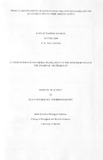| dc.description.abstract | Dioseorea (Yams) in Kenya is a neglected crop, notwithstanding its potential as food and in
pharmaceutics as a drug source. Research on neglected crops specifically Dioseorea is a sure
way of sensitizing the scientific community and policy makers about it. This study used three
universal molecular markers (matK, rbcl., trnF_L) to investigate the species position of
cultivated Kenyan yams and identify their relatedness to major African species and to species
in the gene bank.The study also used Reverse Phase High Performance Liquid
Chromatography (RP-HPLC) to identify and quantify dioscin content in Kenyan yams.
Dioscin was targeted due to its importance as a source of steroidal drugs.
DNA was extracted from tubers and leaf samples and Polymerase Chain Reaction (PCR)
carried out on the DNA samples with direct sequencing of the PCR products. DNA sequences
were assembled with sequencher'" and multiple sequence alignment through clustalW in
megalign from which phylogenetic trees were drawn. Dioscinwas extracted from freeze dried
tubers, extracted in methanol under sonication and quantified in HPLC UVNis light detector.
Results indicated that taxonomic position of Kenyan cultivated yams collected in this study
belong to 7 major species represented by Dioseorea cayanensis, D. alata, D. rotundata, D.
mangenotiana, D. dumetorum, D. sehimperiana and D. bulbifera. Two (D. sehimperiana and
D. mangenotiana) of the seven have never been documented to be under cultivation in
Kenyan before. Dioscin was identified in the Kenyan yam samples under study, albeit at low
concentration (v/v). The quantities of dioscin were variable with the least being 0.884 parts
per billion (Ppb) and the highest 5.12 ppb. Dioscin quantities did not relate to the species
observed and was found to vary in even the same species. This work opens up research into
yams which is still facing neglect from both the scientific community and the farmers | en |

